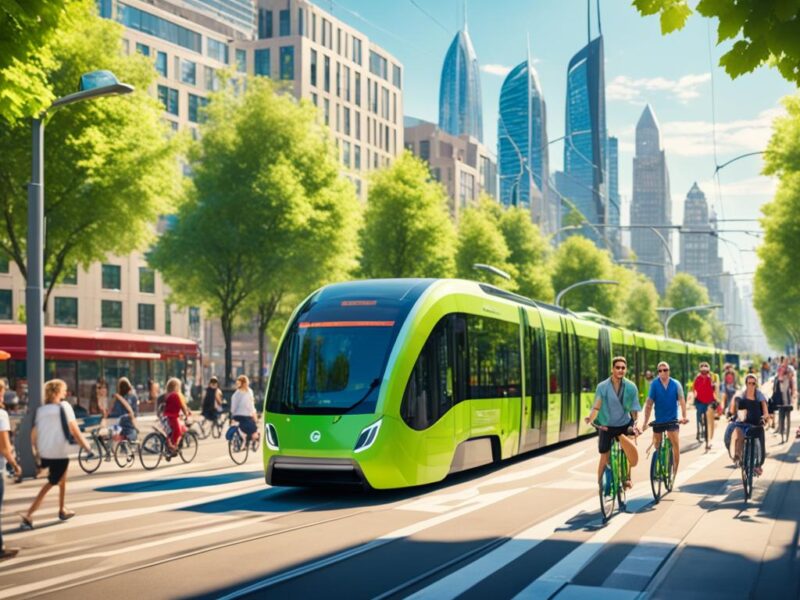
The Role of Robotics in Civil Engineering and Construction
Did you know that the robotics industry is projected to reach a staggering $241.04 billion by 2026? This surprising statistic showcases the immense growth and impact of robotics technology in various sectors, including civil engineering and construction. The integration of robotic systems and automated technologies has revolutionized the way construction projects are planned, executed, and managed, leading to increased productivity, improved safety, and enhanced construction quality.
Key Takeaways:
- Robotics technology is rapidly expanding and is expected to reach $241.04 billion by 2026.
- The integration of robotics and automation has transformed the civil engineering and construction industry.
- Benefits include increased productivity, improved safety, and enhanced construction quality.
- Challenges such as job displacement and high implementation costs must be considered.
- The future of automation and robotics in civil engineering looks promising, with advancements in collaborative robotics, autonomous vehicles, and sustainable construction.
The Benefits of Automation and Robotics in Civil Engineering
Automation and robotics have revolutionized the field of civil engineering, offering numerous advantages that improve construction processes and project outcomes. These technologies have transformed the industry, leading to increased productivity, efficient drilling and excavation, the ability to tackle challenging tasks, enhanced safety, and improved construction quality.
One of the main benefits of automation and robotics in civil engineering is the significant increase in productivity. Machines and robots can work faster and more efficiently than humans, allowing for the quick completion of tasks and projects. With the use of automated systems, construction processes become streamlined and optimized, resulting in time and cost savings.
Moreover, automation and robotics have revolutionized drilling and excavation processes. These technologies enable precise and accurate drilling and excavation, eliminating the need for manual labor-intensive methods. Through the use of advanced machinery and robotic systems, construction companies can complete these tasks more quickly and with higher precision, minimizing errors and delays.
Automation and robotics also make it possible to tackle previously difficult or impossible tasks in civil engineering. For example, drones equipped with advanced imaging technology can be used for surveying and mapping large construction sites, providing accurate data for project planning and monitoring. Additionally, robots can be employed for precision tasks such as welding, ensuring high-quality and durable construction.
Enhanced safety is another key benefit of automation and robotics in civil engineering. By replacing manual labor with automated systems, the risk of accidents and injuries on construction sites is significantly reduced. Robots can perform hazardous tasks, handle heavy materials, and access hard-to-reach areas, minimizing the potential dangers to human workers.
Furthermore, automation and robotics contribute to improved construction quality. With the precision and accuracy of robotic systems, construction projects are built to exact specifications, resulting in higher quality structures. These technologies also facilitate data collection and analysis, enabling real-time monitoring and adjustment throughout the construction process, ensuring compliance with quality standards.
In summary, the benefits of automation and robotics in civil engineering are undeniable. Increased productivity, efficient drilling and excavation, the ability to tackle challenging tasks, enhanced safety, and improved construction quality are just some of the advantages that these technologies bring to the industry. As technology continues to advance, the potential for further innovations and improvements in civil engineering construction processes is vast.
| Benefits of Automation and Robotics in Civil Engineering |
|---|
| Increased Productivity |
| Efficient Drilling and Excavation |
| Tackling Challenging Tasks |
| Enhanced Safety |
| Improved Construction Quality |
Challenges and Potential Drawbacks of Automation and Robotics in Civil Engineering
While automation and robotics offer numerous benefits to the civil engineering industry, there are also challenges and potential drawbacks that need to be considered. These include:
1. Job Displacement
The widespread adoption of automation and robotics in civil engineering has raised concerns about job displacement. As machines and robots become capable of performing tasks that were traditionally done by human workers, there is a risk of unemployment and a significant impact on the job market.
2. High Implementation Costs
The implementation of automation and robotics technologies in civil engineering can be costly. It requires significant capital investment for acquiring the necessary equipment, conducting specialized training programs, establishing maintenance protocols, and providing ongoing technical support.
3. Regulatory and Legal Challenges
The use of automation and robotics in civil engineering may present regulatory and legal challenges. There may be specific regulations to follow, permits to obtain, and compliance requirements to meet, which can add complexity and costs to the adoption of these technologies.
It is important for civil engineering firms to carefully consider these challenges and potential drawbacks. By addressing these concerns proactively, organizations can navigate the implementation of automation and robotics more effectively, maximizing the benefits while minimizing the negative impacts.

Pros and Cons of Automation and Robotics in Civil Engineering
| Pros | Cons |
|---|---|
| Increased productivity | Job displacement |
| Enhanced safety | High implementation costs |
| Improved construction quality | Regulatory and legal challenges |
The Future of Automation and Robotics in Civil Engineering and Construction
The future of automation and robotics in civil engineering and construction looks promising. With increasing awareness and understanding of their benefits, we can expect to see a greater adoption of these technologies in the industry. This will lead to improved efficiency, safety, and sustainability in construction projects.
Rise of Collaborative Robotics
Collaborative robotics, also known as cobots, is an emerging trend in the field of automation. These robots are designed to work alongside humans, assisting them in various tasks. The increased adoption of collaborative robotics in civil engineering and construction will revolutionize the industry by combining the strengths of human workers with the precision and strength of robotic systems. This collaboration will not only enhance productivity but also ensure the safety of workers in hazardous environments.
Autonomous Vehicles and Equipment
Autonomous vehicles and equipment will play a crucial role in the future of construction. These self-driving machines will have the ability to navigate construction sites, transport materials, and perform tasks independently. By eliminating the need for human operators, autonomous vehicles and equipment will improve efficiency, reduce errors, and minimize the risk of accidents.
Construction Site Monitoring
Construction site monitoring will be revolutionized by advanced technologies such as IoT sensors and drones. These technologies will enable real-time data gathering and decision-making, allowing project managers to monitor progress, identify potential issues, and make informed decisions promptly. By utilizing construction site monitoring technologies, construction projects can be completed more efficiently and with higher quality.
Building Information Modeling (BIM)
Building Information Modeling (BIM) will continue to play a crucial role in the integration of robotics and automation in civil engineering and construction. BIM allows for precise and coordinated construction processes by creating digital representations of buildings and infrastructure projects. By leveraging BIM, construction professionals can effectively plan, design, and manage projects while seamlessly integrating robotics and automation systems.
Artificial Intelligence and Machine Learning
Artificial intelligence (AI) and machine learning will further enhance the capabilities of automation and robotics in civil engineering and construction. AI algorithms can optimize the performance of robotic systems, making them more efficient and effective in completing tasks. Machine learning algorithms can analyze construction data to predict maintenance needs, ensuring timely interventions and reducing downtime.
Promoting Sustainability and Green Construction
The future of automation and robotics in civil engineering and construction aligns with the growing focus on sustainability and green construction practices. These technologies can contribute to reducing waste and energy consumption, making construction processes more environmentally friendly. By incorporating automation and robotics, construction companies can adopt sustainable practices while maintaining high productivity and efficiency levels.
“The integration of automation and robotics in civil engineering and construction will usher in a new era of efficiency, safety, and sustainability in the industry.”
The Future Table
| Technologies | Benefits |
|---|---|
| Collaborative robotics | Improved productivity, enhanced safety |
| Autonomous vehicles and equipment | Increased efficiency, reduced accidents |
| Construction site monitoring | Real-time data gathering, informed decision-making |
| Building Information Modeling (BIM) | Precise and coordinated construction processes |
| Artificial intelligence and machine learning | Optimized performance, predictive maintenance |
| Sustainability and green construction | Reduced waste, energy-efficient practices |
The Implications of Automation and Robotics in Civil Engineering and Construction
Automation and robotics have brought about significant implications for the civil engineering and construction industry. These technologies have not only revolutionized processes but also had a profound impact on various aspects of construction projects.
Increased productivity: One of the key benefits of automation and robotics is the immense boost in productivity they bring. Machines and robots are capable of performing tasks faster and more efficiently than human labor, leading to accelerated project timelines and increased output.
Improved safety: Safety is a paramount concern in the construction industry, and automation and robotics play a crucial role in enhancing it. By replacing humans with machines for high-risk tasks, the risk of accidents and injuries can be significantly reduced, ensuring a safer working environment.
Higher construction quality: Automation and robotics contribute to improved construction quality. These technologies offer precision and accuracy in various tasks, eliminating errors commonly associated with human labor. As a result, the final output is of superior quality with minimal defects.
“Automation and robotics in civil engineering and construction not only increase productivity but also improve safety and result in higher construction quality.”
Despite the numerous benefits, concerns surrounding the impact on the job market persist. The automation of certain tasks and the introduction of robots may lead to job displacement, affecting the employment prospects of workers in the industry. However, it’s crucial to note that automation also brings new opportunities for skilled workers who can operate and maintain these technologies.
Moreover, the integration of automation and robotics in civil engineering and construction drives technological advancements. As companies strive to stay competitive and embrace these technologies, research and development efforts are being accelerated, resulting in new and innovative solutions for the industry.
Additionally, the adoption of automation and robotics has economic implications. While the initial implementation costs may be high, the long-term benefits, such as increased productivity and improved efficiency, outweigh the expenses. Furthermore, automation and robotics contribute to sustainable construction practices, reducing waste and energy consumption, which have positive economic and environmental effects.
As the industry continues to evolve, automation and robotics will remain at the forefront of innovation and progress. These technologies will continue to shape the future of civil engineering and construction, driving productivity, safety, and construction quality to new heights.
Implications of Automation and Robotics in Civil Engineering and Construction
| Implication | Description |
|---|---|
| Increased Productivity | Machines and robots perform tasks faster and more efficiently, resulting in accelerated project timelines and increased output. |
| Improved Safety | Replacing humans with machines for high-risk tasks reduces the risk of accidents and injuries, creating a safer working environment. |
| Higher Construction Quality | Automation and robotics offer precision and accuracy, minimizing errors and delivering construction projects of superior quality. |
| Job Market Impact | While automation may lead to job displacement, it also creates new employment opportunities for skilled workers. |
| Technological Advancements | The integration of automation and robotics drives research and development efforts, leading to new and innovative solutions for the industry. |
| Economic Implications | Despite initial implementation costs, automation and robotics contribute to increased productivity, efficiency, and sustainability. |
Conclusion
The integration of automation and robotics has transformed the civil engineering and construction industry, offering a myriad of benefits. These advanced technologies have significantly improved productivity, safety, and the overall quality of construction projects. Despite the potential challenges and drawbacks, the future of automation and robotics in the industry looks promising.
Robotics in civil engineering and construction have revolutionized the way tasks are carried out, resulting in increased productivity. With the ability to work faster and more efficiently than humans, machines and robots have accelerated the completion of construction projects. Additionally, automation and robotics have brought advancements in drilling, excavation, and precision tasks, enhancing the accuracy and speed of these critical activities.
The future of automation and robotics in civil engineering holds immense potential. Collaborative robotics and autonomous vehicles are expected to become more prevalent, driving efficiency and safety in construction sites. Technological advancements, such as building information modeling (BIM), artificial intelligence, and machine learning, will further optimize the capabilities of these technologies, leading to more precise and coordinated construction processes. The integration of automation and robotics will also contribute to sustainable construction practices, reducing waste and energy consumption.
In conclusion, as the civil engineering and construction industry continues to embrace automation and robotics, the benefits of these technologies will become increasingly evident. Increased adoption, collaborative robotics, autonomous vehicles, and ongoing technological advancements will shape the future, providing a more efficient and sustainable approach to civil engineering and construction projects.
FAQ
How has robotics technology impacted civil engineering and construction?
What are the benefits of automation and robotics in civil engineering?
What are the potential challenges and drawbacks of automation and robotics in civil engineering?
What does the future hold for automation and robotics in civil engineering and construction?
What are the implications of automation and robotics in civil engineering and construction?
How has robotics technology impacted the construction industry?
Source Links
- https://www.mcneilengineering.com/the-impact-of-automation-and-robotics-on-civil-engineering-construction-processes/
- https://skill-lync.com/blogs/the-impact-of-automation-and-robotics-in-the-civil-engineering-industry
- https://www.linkedin.com/pulse/robotics-construction-industry-2022-use-benefits-types-reetie-multani







